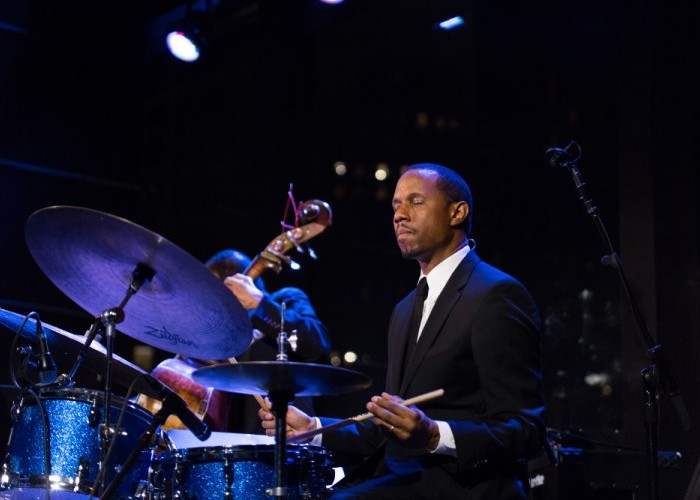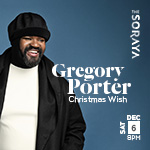Oct 28, 2025 10:47 AM
In Memoriam: Jack DeJohnette, 1942–2025
Jack DeJohnette, a bold and resourceful drummer and NEA Jazz Master who forged a unique vocabulary on the kit over his…

My Point is ... is drummer Willie Jones III’s most recent long-playing album.
(Photo: Anna Yatskevich)Moore was referring to his new album, Three Score, which is an intense quartet recital with Reed, Jones and bassist Gerald Cannon. It’s the saxophonist’s first leader album since 1993, a few years before he heard Jones for the first time. The event was a Sunday cocktail hour gig that Moore held with fellow Tonight Show band members Robert Hurst and Marvin “Smitty” Smith at a bar in Inglewood called the Main Event. “When Smitty couldn’t make it, Willie was the first call,” Moore said. “He never said a word—just set up his drums, took care of business, and left. A few years later, I went to Catalina’s Bar and Grill [in Los Angeles] and he was there with Roy Hargrove. He’d moved to New York. When a musician moves to New York, he or she gets some kind of edge, an awareness about the music that they didn’t have before. Willie definitely had it.”
Before relocating to New York in 1997, Jones had accumulated a formidable c.v. as a working L.A. musician—consequential touring with Arturo Sandoval; weekly sinecures at local boîtes; gigs with West Coast heroes like Teddy Edwards, Billy Childs and Kei Akagi; and albums for Sony and Impulse! with Black Note, a collective combo with bassist Marcus Shelby, trumpeter Gilbert Castellanos and alto saxophonist James Mahone. He met them at the World Stage, the workshop-performing space that poet Kamau Daáood and drummer Billy Higgins co-founded in Leimert Park in 1989.
“Billy was always in my ear,” Jones said. “He told me from the beginning, ‘What you’re doing here is ne, but you want to go to New York. Don’t get too comfortable.’ He also was the first one who put the bug in my ear about having a label. He always talked about Strata-East [the label founded by Charles Tolliver and Stanley Cowell in 1971]. I never studied with him officially, but I’d watch him practice at midnight. That’s the best drum lesson you can get.”
During these years, Jones was taking official lessons with Albert “Tootie” Heath at California Institute of the Arts. “I knew I wanted to be a jazz musician as early as 7,” Jones recalled. “But at CalArts they hipped me what to listen for, what I needed to do and how to go about it. I had technique at that point. Tootie didn’t need to teach me paradiddles. He was always like, ‘Let me hear you play.’ Back then, the concept of phrasing wasn’t in my vocabulary. It was like one stream of consciousness. Tootie said, ‘Man, that’s great, but you’ve got to say something. What are you trying to tell me?’
“Two years later, he got me on a three-week tour with Milt Jackson that he couldn’t make, and Milt Jackson said the same thing: ‘You want to play music; you don’t want to play drums.’ He also told me, ‘If I have to count while you’re soloing, then you’re not playing anything.’
So I tell my students: ‘I should just be able to listen to how you’re phrasing on the kit, and I should know where we are in the tune.’”
Jones inherited his jazz obsession from his namesake father, a pianist, composer and arranger who moved from Jacksonville to L.A. in 1961 at the instigation of his childhood friend Freddie Hill, a trumpeter whose credits include multiple appearances with Gerald Wilson during the 1960s. Six weeks after he’d arrived, père Jones became pianist and music director for The Platters, the popular vocal group. By 1968, when Jones was born, he was gigging locally and working as a vocal coach for entertainers, including Ann-Margaret.
“My father knew all the musicians,” Jones said. “I met Higgins when I was a kid, although I didn’t know who he was then. I got to know [drummer] Larance Marable and Henry Franklin very well, and I met Teddy Edwards, who I played with when I was older. My father loved all black music and was into gospel, but he was a bebopper at heart. I think he had his own voice—he loved Bill Evans, Oscar Peterson and Wynton Kelly, but I don’t think he sounded like any of them. He was very thorough rhythmically and harmonically. He’d have rehearsals at the house, and I’d get all excited just watching the drummer set up the drums. Then I’d sit right next to the floor tom watching him play.”
“Willie’s father was sort of like the Detroit session cats who did all those Motown records,” Reed said. “His jazz playing was funky and jagged—it reminded me of [pianist] Elmo Hope.”
Reed’s November release, a hardcore jazz- meets-gospel quartet recital titled A Light In Darkness, is his fourth on WJ3. He and Jones first shared a bandstand circa 1985 on a gospel gig with Jones’ uncle by marriage, singer-preacher Eric Claybon. “Meeting Willie helped me fuse a lot of things I was trying to do in combining gospel and jazz music,” Reed said. “We’d both grown up on so many different types of music, including r&b and pop. We just wanted to play. He always played with taste. He loves to play time. Like Billy Higgins, he doesn’t talk a lot; he reminds me of Higgins because his swing has a West Coast swagger, with a looseness that isn’t lackadaisical and an edge that isn’t overwhelming.”
As Jones approaches age 50, he’ll follow his lodestar principle of “documenting my stage of development.” He continued, “If I’m around musicians writing originals, or if we’re playing standards, that’s what we’ll record.”
Jones mentioned his 2013 WJ3 release,Plays The Max Roach Songbook, capturing an event at Dizzy’s Club Coca-Cola. “That concept was suggested to me as a show, then they recorded it and I decided to put it out,” Jones said. “But I didn’t sit down and think about doing a record dedicated to Max or Art Blakey or Billy Higgins—although I do have an idea for Billy. So many roads go through Higgins.”

Jack DeJohnette boasted a musical resume that was as long as it was fearsome.
Oct 28, 2025 10:47 AM
Jack DeJohnette, a bold and resourceful drummer and NEA Jazz Master who forged a unique vocabulary on the kit over his…

D’Angelo achieved commercial and critical success experimenting with a fusion of jazz, funk, soul, R&B and hip-hop.
Oct 14, 2025 1:47 PM
D’Angelo, a Grammy-winning R&B and neo-soul singer, guitarist and pianist who exerted a profound influence on 21st…

To see the complete list of nominations for the 2026 Grammy Awards, go to grammy.com.
Nov 11, 2025 12:35 PM
The nominations for the 2026 Grammy Awards are in, with plenty to smile about for the worlds of jazz, blues and beyond.…

Jim McNeely’s singular body of work had a profound and lasting influence on many of today’s top jazz composers in the U.S. and in Europe.
Oct 7, 2025 3:40 PM
Pianist Jim McNeely, one of the most distinguished large ensemble jazz composers of his generation, died Sept. 26 at…

Drummond was cherished by generations of mainstream jazz listeners and bandleaders for his authoritative tonal presence, a defining quality of his style most apparent when he played his instrument unamplified.
Nov 4, 2025 11:39 AM
Ray Drummond, a first-call bassist who appeared on hundreds of albums as a sideman for some of the top names in jazz…






